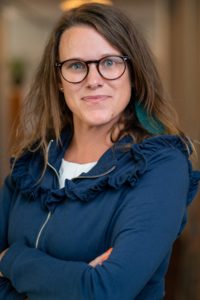Umeå Municipality has positioned itself as a leader in equal urban development in Europe. International visitors travel to northern Sweden to discover how the strategic work is carried out. “This is thanks to a long tradition of integrating gender equality into all issues related to urban planning and infrastructure,” says Gender Equality Officer Linda Gustafsson.
Her job is an example of how Umeå has worked purposefully on equal urban development – the gender equality service has been around since the late 1980s. Before that, Umeå was very early to have a woman as chair of the building committee and the city also has a history of a strong women’s movement that has promoted women’s issues. Umeå University also runs the Umeå Centre for Gender Studies where interdisciplinary research is conducted.
All in all, this has meant that the city has naturally integrated the gendered landscape with other issues that relate to the development of the city.

Linda Gustafsson
“I am often involved as an expert in groups where gender equality and sustainability issues need to be illustrated and now the natural way of thinking is to ask questions such as: who is going to live here? How are they going to move around? How do we perceive living environments differently? It is about having an overall focus and how this is expressed in the city,” says Linda.
Wish to create networks
As part of missionising the city of Umeå’s unique way of working, where gender issues are involved and incorporated into initiatives in the environment, climate and social sustainability, the bus tour “The Gendered Landscape” has been organised in Umeå. It is Linda herself who guides the tour through Umeå and the different destinations are determined based on which group is visiting.
“Of course, we want to show how far we have come in Umeå, partly as a good example so as to inspire other cities, but also to create networks where we can inspire each other. We want to find out about other cities’ success stories and ways of taking on the challenges that may exist,” says Linda.
Over the years, many national and international decision-makers in the public sector have taken the bus through Umeå. Politicians, various officials from cities and authorities, architects or urban planners. More recently, Umeå has also attracted those who work on climate and social sustainability issues, as well as students.
“Of course, it feels great that we can make what is being done in Umeå more visible. We get a lot of positive reactions from visitors who say ‘this is something I’ve never thought about’. That is a eureka moment and it’s exactly the kind of feedback we want,” says Linda.
A tunnel for all
Opening your eyes to how a travel centre, an underpass or a car park can have a connection with power and gender is the aim of the bus journey and there are a few destinations to choose between:
The LEV tunnel in central Umeå
It connects the city centre with the train station and the Haga district. The large inflow of light, rounded corners and a wide entrance are the results of a splash of the gendered landscape. Anyone who walks or cycles through it can also listen to author Sara Lidman’s pleasant voice from speakers.
“I usually draw attention to the company that Sara Lidman gives you in the tunnel – the voice, the sounds and all the quotes from her on the wall – the whole work of art has a cosy and sheltered feeling,” says Linda and continues:
“Choice of material and artistic design play a part. How do you decorate the place? It should be a place where residents and visitors should have a feeling of a right to be there and that someone is taking care of this public space.”
Umeå East Station
Another example is the new travel centre at Umeå East station, which is a hub for travellers to and from Norrland University Hospital and Umeå University. This has been built with as much open space as possible so that travellers can feel safe.
“A large proportion of women work in the hospital and in health care in general, and many of them have inconvenient working hours. Everyone should feel safe when commuting to and from work and it is therefore important that the travel centre is open and transparent, without places where you can be surprised by another person. Here, it is also easy to use public transport or cycle to get to work. But if you look at larger, male-dominated workplaces, we do not have the same public transport flows at all. It puts a structure in a family – who takes the car and who takes the bus,” says Linda.
In total, there are 25 stops on the bus tour that takes visitors around the city to show them how well-thought-out urban development can mean something for gender equality in society.
Read more about the study visits here!